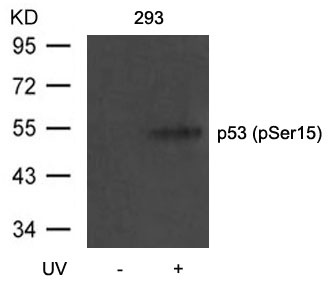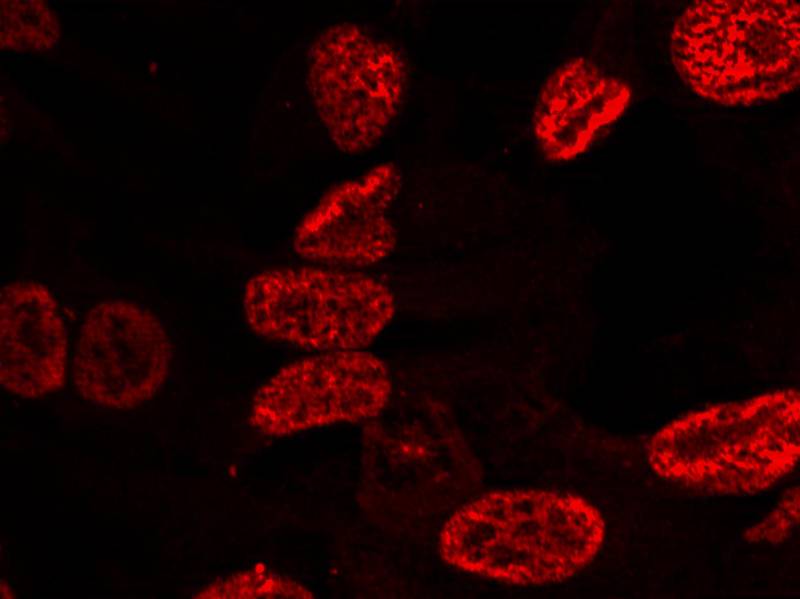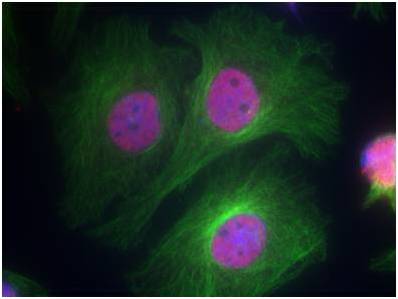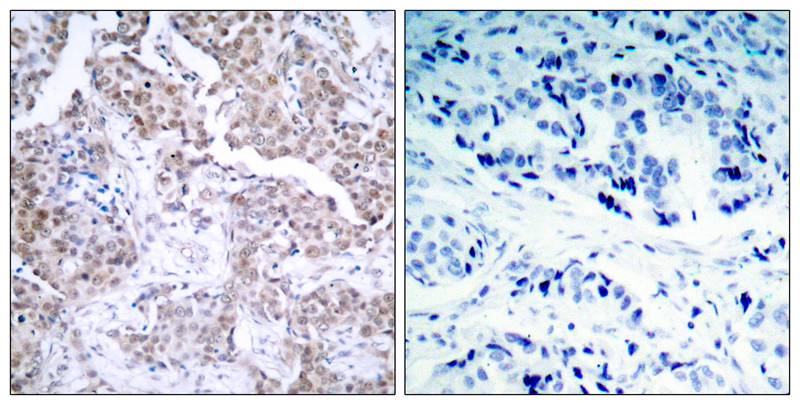



| WB | 咨询技术 | Human,Mouse,Rat |
| IF | 咨询技术 | Human,Mouse,Rat |
| IHC | 1/50-1/100 | Human,Mouse,Rat |
| ICC | 1/100-1/200 | Human,Mouse,Rat |
| FCM | 咨询技术 | Human,Mouse,Rat |
| Elisa | 咨询技术 | Human,Mouse,Rat |
| Aliases | Tumor suppressor p53; Phosphoprotein p53; Antigen NY-CO-13; TP53; |
| Entrez GeneID | 7157; |
| WB Predicted band size | 53kDa |
| Host/Isotype | Rabbit IgG |
| Antibody Type | Primary antibody |
| Storage | Store at 4°C short term. Aliquot and store at -20°C long term. Avoid freeze/thaw cycles. |
| Species Reactivity | Human |
| Immunogen | Peptide sequence around phosphorylation site of serine 15 (P-L-S(p)-Q-E) derived from Human p53. |
| Formulation | Purified antibody in PBS with 0.05% sodium azide. |
+ +
以下是3篇与p53(Phospho-Ser15)抗体相关的经典文献摘要概括:
1. **文献名称**: "Phosphorylation of Serine 15 and 20 in p53 Modulates Its Interaction with Human MDM2"
**作者**: Tibbetts, R.S. et al.
**摘要**: 该研究证实DNA损伤诱导的p53 Ser15磷酸化通过ATM激酶介导,抑制其与MDM2的结合,从而稳定p53蛋白并增强转录活性,揭示了磷酸化调控p53功能的重要机制。
2. **文献名称**: "DNA Damage-Induced Phosphorylation of p53 Alleviates Inhibition by MDM2"
**作者**: Shieh, S.Y. et al.
**摘要**: 研究发现电离辐射诱导的p53 Ser15磷酸化直接削弱MDM2对p53的泛素化降解作用,通过ChIP和Western blot实验(使用Phospho-Ser15抗体)证明该修饰促进p53在靶基因启动子的聚集。
3. **文献名称**: "Activation of the ATM Kinase by DNA Damage and Phosphorylation of p53"
**作者**: Kastan, M.B. et al.
**摘要**: 首次建立ATM激酶与p53 Ser15磷酸化的直接联系,通过免疫沉淀和激酶实验证明ATM是DNA损伤后p53 Ser15磷酸化的关键激酶,该修饰触发细胞周期停滞或凋亡。
注:以上文献均发表于1999-2001年的*Science*和*Cell*期刊,是p53磷酸化调控领域的奠基性研究。若需具体年份或PMID号可进一步补充。
The p53 protein, a critical tumor suppressor, plays a central role in regulating cell cycle arrest, DNA repair, apoptosis, and genomic stability. Post-translational modifications, particularly phosphorylation, modulate its activity in response to cellular stress. Phosphorylation at serine 15 (Ser15) is a key regulatory event occurring during DNA damage. This modification is primarily mediated by the ataxia-telangiectasia mutated (ATM) and ATM- and Rad3-related (ATR) kinases, which are activated in response to DNA double-strand breaks or replication stress. Phospho-Ser15 stabilizes p53 by disrupting its interaction with the E3 ubiquitin ligase MDM2. thereby preventing proteasomal degradation and enhancing its transcriptional activity.
The p53 (Phospho-Ser15) antibody specifically detects this phosphorylation event, serving as a valuable tool to study p53 activation under stress conditions. It is widely used in techniques like Western blotting, immunohistochemistry, and immunofluorescence to assess DNA damage responses, therapeutic efficacy of genotoxic agents, or oncogenic signaling in cancer research. Elevated Ser15 phosphorylation is often linked to tumor progression, chemoresistance, or poor prognosis, making this antibody essential for investigating p53-related pathways in both basic and clinical contexts. Its specificity ensures accurate detection of the activated p53 form, aiding mechanistic studies of carcinogenesis and therapeutic targeting.
×